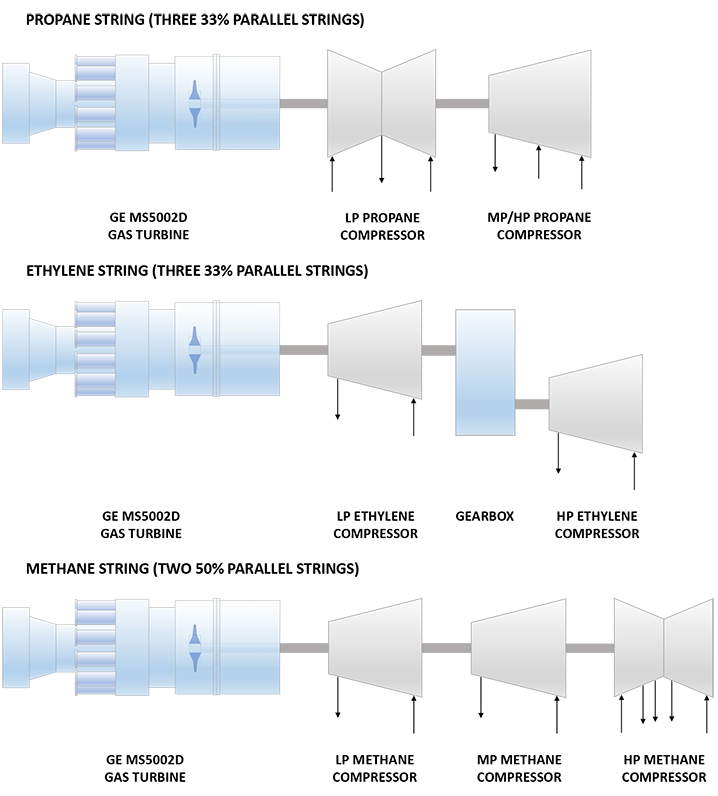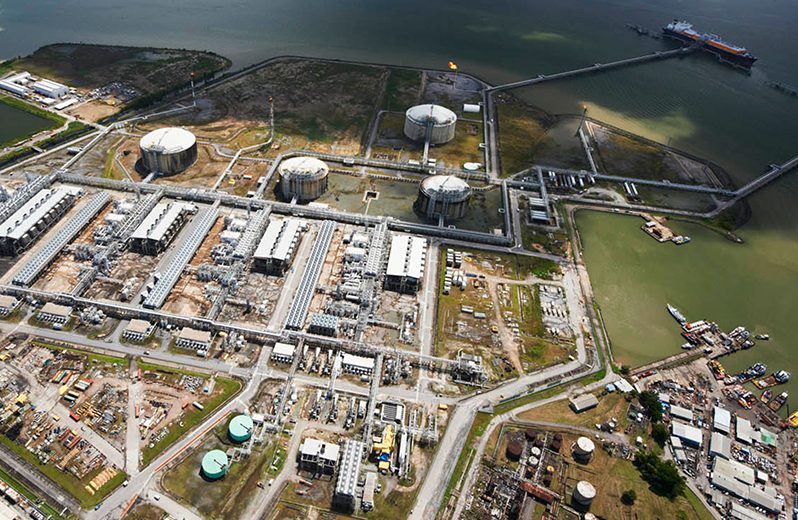In 1992, Cabot LNG signed an MOU with National Gas Company of Trinidad and Tobago, Amoco and British Gas plc to initiate a feasibility study for the Atlantic LNG project. On July 20, 1995, The Atlantic LNG Company of Trinidad and Tobago was founded by the 4-way partnership, which popularly came to be known as the “The Trinidad Model”. Cabot agreed to purchase LNG for a period of 20 years and AMOCO Trinidad Oil Company in return agreed to supply gas to facilitate its liquefaction. The project also signed a long-term SPA with Enagas. At the time, British Gas’ only presence in LNG was as a ship owner while Amoco and NGC had no LNG experience. Coming into the project with an ‘outside’ perspective, allowed the companies to bring several commercial innovations to the project such as sales Contracts that allowed switching of destinations and a competitive “dual FEED” strategy that helped reduce project EPC costs significantly. With an intent to sell the LNG predominantly to a lower priced US market, the commercial innovations were critical to making the project viable.
Within a year, construction was initiated to build a single train LNG plant on reclaimed land at Point Fortin. The plant would be a purely processing operation and would export LNG and natural gas liquids (NGLs) using supply from offshore fields north and east of Trinidad. Construction took about 3 years, with first cargo being shipped to Boston in May 1999. The plant became not only the second ever LNG plant in the Western Hemisphere, but also the second ever plant to use the Phillips Petroleum Co.’s (later ConocoPhillips) Optimized Cascade process in the over 35-year long history of LNG.
The success of the project triggered off expansion plans almost immediately after operations commenced. In March 2000, Atlantic LNG and the Government of Trinidad and Tobago agreed to add 2 additional trains of capacity 3.30 MMTPA and 6,000 bpd of natural gas liquids (NGLs). Trains 2 and 3 commenced commercial operations in August 2002 and April 2003 respectively. The momentum continued with the construction of the fourth train starting in 2003. In December 2005, Atlantic LNG showcased production from the largest train in the world of its time, with a capacity of 5.20 MMTPA of LNG.
By 2014, Atlantic LNG had already dispatched 3000 shipments. The project, with a fleet of 27 GE Frame 5 turbine driven compressors, prides itself as the largest Frame 5 fleet in the world.1 The facility also boasts of an industry-leading safety record of 35 million manhours without a Lost Time Injury (LTI).2 Over 650 full time personnel are employed by Atlantic LNG, 98% of which are nationals of Trinidad and Tobago. In addition, over 1000 contractors are engaged in the maintenance of the facility.
Atlantic LNG’s sustainability programmes are aimed at creating far reaching opportunities and long-term impact in the local and national community in various areas, including Sports, Education, Local Economic Development and Environment. The initiatives include the Atlantic Coaching Excellence (ACE) Programme for training coaches at the primary school level, the Atlantic National Energy Skills Centre (NESC) for technical and vocational skills training, Point Fortin’s Finest scholarship programme, the Atlantic/IDB Local Economic Development (LED) Programme for building capacity and development opportunities, as well as sports programs ranging from Cricket and Soccer to Track & Field, Swimming and Tennis. Atlantic LNG also collaborates with the Fondes Amandes Community Reforestation Programme and the National Sea Turtle Tagging and Monitoring Programme.3
OWNERSHIP (Equity %)
| Shell | 51.10% |
| BP (Barbados) Holding SRL | 37.80% |
| NGC LNG (Train 4) Limited | 11.10% |
General Data
| Estimated Capital Cost (USD) | 1.2 B |
| Plant Type | Onshore Stick-built |
| Plant Stage | Operating |
| Final Investment Decision (FID) Year | 2001 |
| FEED Contractor | Bechtel |
| EPC Contractor | Bechtel |
| No. of Trains / capacity | 1 Train / 5.2 MMTPA |
| Production Start Year | 2006 |
| Products | LNG, Propane, Butane, Condensate |
| Gas Type | Non-associated Gas (NAG) |
Technical Data
| Cooling Media | Air |
| Liquefaction Technology | CoP Optimized Cascade® |
| Refrigeration Train Details: | |
| Propane Strings 1 & 2 & 3 | |
| Driver | GE MS5432D (Frame 5D) Heavy Duty Gas Turbine |
| Low Pressure (LP) Propane Compressor | GE (Nuovo Pignone) Horizontally Split Centrifugal Compressor |
| Medium Pressure (MP) / High Pressure (HP) Propane Compressor | GE (Nuovo Pignone) Horizontally Split Centrifugal Compressor |
| Ethylene Strings 1 & 2 & 3 | |
| Driver | GE MS5432D (Frame 5D) Heavy Duty Gas Turbine |
| Low Pressure (LP) Ethylene Compressor | GE (Nuovo Pignone) Horizontally Split Centrifugal Compressor |
| Gearbox | Double helical speed increasing gearbox |
| High Pressure (HP) Ethylene Compressor | GE (Nuovo Pignone) Horizontally Split Centrifugal Compressor |
| Methane Strings 1 & 2 | |
| Driver | GE MS5432D (Frame 5D) Heavy Duty Gas Turbine |
| Low Pressure (LP) Methane Compressor | GE (Nuovo Pignone) Horizontally Split Centrifugal Compressor |
| Medium Pressure (MP) Methane Compressor | GE (Nuovo Pignone) Horizontally Split Centrifugal Compressor |
| High Pressure (HP) Methane Compressor | GE (Nuovo Pignone) Horizontally Split Centrifugal Compressor |
| Power Generation | 3 x Solar Mars 100 Gas Turbine Generators + 1 x Solar Mars 100 Gas Turbine added to Trains 1-3 Utilities |
Refrigeration Train Configuration

Key Facts
- At the commencement of operations, Atlantic LNG Train 4 was the largest LNG train in the world with a capacity of 5.2 MMTPA of LNG.
- Increase in production for Train 4 was achieved by adding additional refrigeration compressors and propane condensers. One additional propane and ethylene string was added. Intercoolers were added to the methane compressors above the standard design to improve efficiency resulting in increased LNG production. The single propane compressor case was split into two casings. The ethylene compressor was also split into two casings and a gearbox was installed between the casings. To provide additional flexibility for day/night ambient temperature variations splitter vanes were utilized in the all the propane compressor impellers.4
- Additional land reclamation was required for the construction of the fourth LNG tank. The fill material the LNG tank area and additional reclaimed land were sourced from the incremental dredging required to widen the existing ship channel. 53 hectares (131 acres) have been reclaimed.4
- The technology for removal of natural gas liquids (NGLs) was improved for Train 4 to achieve higher levels of ethane recovery. Reflux was added to the absorber column in the heavies removal unit to improve the operability and flexibility for the gas compositions anticipated for Train 4. The design accommodates for up to 80% ethane recovery from the natural gas feed stream.4
- During the engineering phase, the use of aero-derivative gas turbines was evaluated for Train 4. However, at the time, the evaluation criteria were based on ‘full cycle economics’ and not environmental considerations. The evaluation concluded that there was “no advantage” of the aero-derivative turbines, and Frame 5D gas turbines were chosen as the drivers for the Train 4 refrigeration compressors.4
- Atlantic LNG developed a gantry-based system for the modular change out of their Frame 5D engines instead of the standard in-situ replacement during major overhauls. This modular approach was designed to save 12 days of downtime for a major overhaul which represented significant savings for the LNG plant given its fleet of 26 Frame 5Ds in continuous operation.5
- Over the years, Atlantic LNG has had multiple changes in ownership:
> The original ownership at the start of Train 4 in 2007 was: BP (37.80%), BG (28.90%), Repsol (22.20%) and NGC (11.10%).6> In 2014, Royal Dutch Shell plc acquired Repsol S.A.’s LNG portfolio outside North America.7> In 2016, Shell officially acquired British Gas (BG) Group plc. As a result, Shell’s total ownership in Train 4 increased to 51.10%.8
Source:
1. ‘Our Trains’, Atlantic LNG Website
2. ‘Atlantic at a Glance’, Atlantic LNG Website
3. ‘Sustainability – Society’, Atlantic LNG Website
4. Diocee T. et al ‘Atlantic LNG Train 4 The World’s Largest LNG Train‘, LNG 14, Doha, Qatar, March 2004
5. Raymer S. et al ‘Revolutionizing Gas Turbine Maintenance in LNG Service‘, ASME Turbo Expo 2005
6. ‘Atlantic LNG – Shareholders’, Wikipedia
7. ‘Shell boosts its leadership in global LNG with the completion of Repsol S.A. LNG deal’, Shell Global Website, 2 January 2014
8. ‘Combination BG Group publications’ Shell Global Website






















































